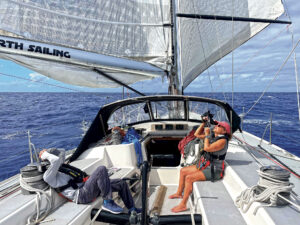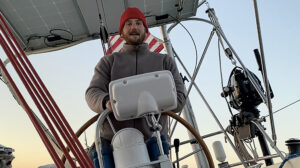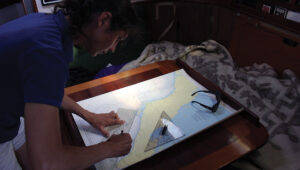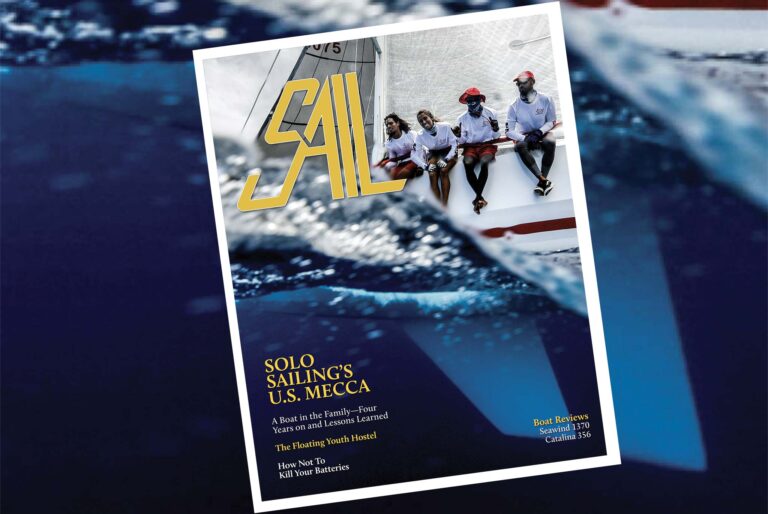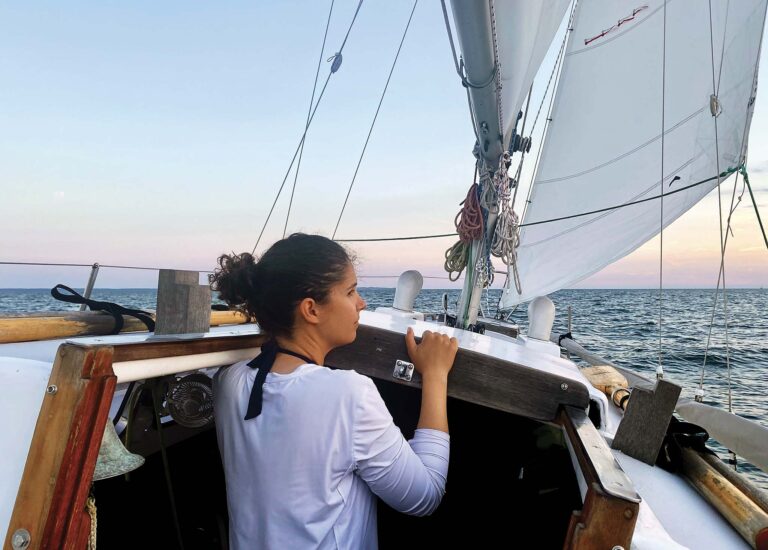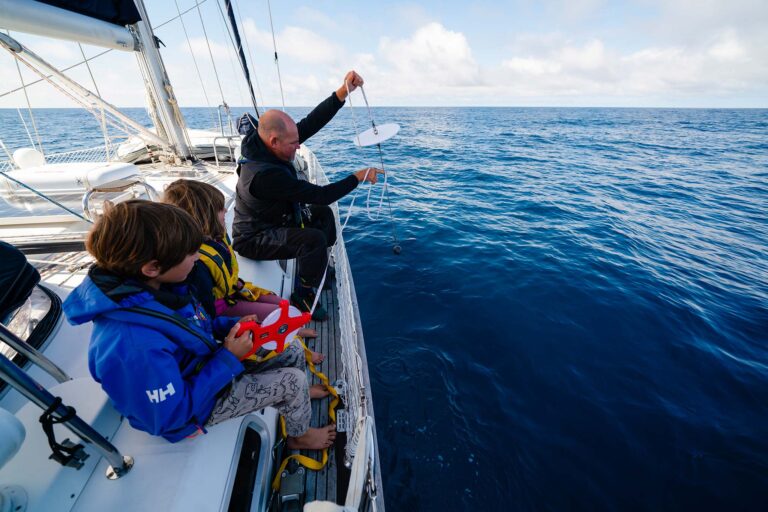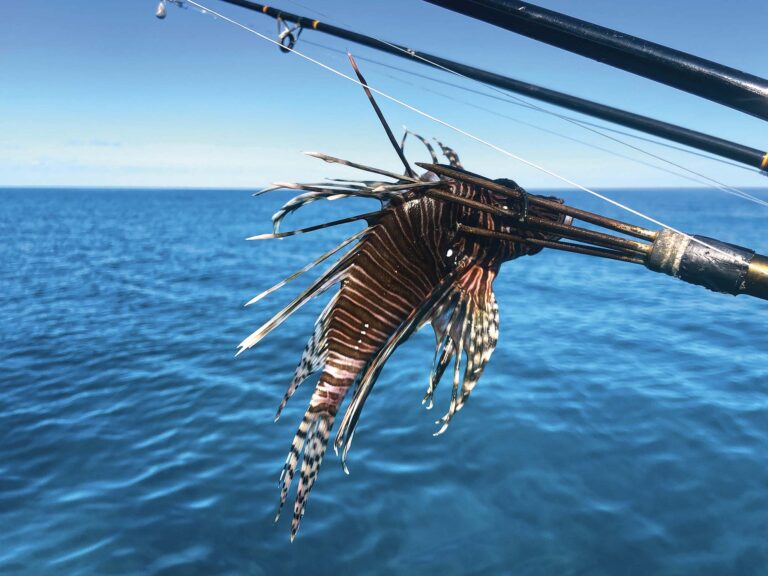
There’s a lot to be said for a trailer sailer. Say goodbye to expensive boatyard haulout and storage fees. Forget about the laborious annual bottom scrub and paint. Park your pride and joy in your backyard so you can keep a fond eye on her over winter. Luxuriate in lower insurance premiums. And as the trailer sailing crowd loves to say, you can go to windward at 55mph on your way to destinations it would take months to sail to on a bigger boat.
Choosing a trailer sailer, though, is no easier than trying to nail down a bigger boat. There are a lot of them, and it seems the only thing they have in common is that they have sails and can be launched and retrieved from a trailer. For the purposes of these articles, we will leave out the many fine sailing dinghies and open boats that can be trailered, and concentrate on those with accommodations sufficient for at least a weekend on the water. We’ve split these into two categories—performance-oriented boats and all-around pocket cruisers. Note also that we are only discussing boats that are currently in production.
Are you never happier than when hugging the coast, exploring shallow waterways, and anchoring in lonely gunkholes? You could be tailor-made for a New England catboat, with its capacious accommodations and easily handled single sail gaff rig. Actually, of the three boats, we looked at only the Marshall Sanderling is built in New England. There are more than 800 of these pretty little boats on the water, and their genesis goes right back to the early days of fiberglass series boatbuilding—the first Sanderling was launched in 1962. Four can sleep comfortably in the roomy cabin, and the cockpit is big enough to hold six people. A self-bailing cockpit makes the Sanderling capable of open-water sailing, and those who want to sail—as opposed to trail—long distances can have a small diesel installed in lieu of the standard outboard.

Built in South Dartmouth, Massachusetts, by the Marshall Marine Corporation (marshallcat.com), the Sanderling is the type of boat that inspires lengthy love affairs with its owners. Who buys them? “It’s a common theme for someone who has done the big-boat thing to end up with one of our boats,” says co-owner Kristen Marshall. “They sail and feel like a much bigger boat than they are.”
Another popular catboat with a long pedigree is built by Com-Pac Yachts (com-pacyachts.com) in Clearwater, Florida, another company with a long history—Rich and Gerry Hutchins started it in 1974. The 20-foot Horizon Cat was designed as a weekender for a couple, and with two large berths, plenty of stowage, and a screened-off head it serves this purpose admirably. Wheel steering, a diesel inboard and Com-Pac’s patented Mastender system, which allowed the rig to easily be deployed or stowed by one person, all serve to make this a popular small cruiser. Like the other Com-Pacs, it has a long lead-ballasted stub keel that houses the centerboard, so there is no centerboard case to intrude into the accommodation.
Com-Pac’s mast raising system make short work of rigging the Eclipse
The Horizon Cat shows its mettle
Com-Pac’s range of trailer sailers with accommodations starts with the 16-feet 6-inch Legacy, an entry-level trailer sailer that can sleep a couple plus a small child or two, but is otherwise devoid of amenities, and moves up through the 21-feet Eclipse, the CP23 Pilothouse and the 23/IV. Aside from their well-thought-out rig-raising systems, Com-Pac’s boats are packed with clever ideas gleaned over decades of producing small boats. On the four-berth Eclipse 21, for instance, moving a few cushions belowdecks reveals a galley sink and worktop, while the companionway step lifts out of the way to reveal a slide-out porta potty. The CP23 Pilothouse won a SAIL Best Boats award for its clever layout; there’s not a cubic inch of space wasted in this boat, which features a full-size V-berth, an inside helm station with all-around visibility, enclosed head/shower, lots of stowage and a diesel engine. The dinette in the pilothouse converts to a double berth.
Another Florida boat, the Seaward 26RK (seawardyachts.com) has genuine offshore chops—Seaward Yachts founder Nick Hake, based in Stuart, Florida, at the time, designed the boat to be able to traverse the Gulf Stream from Florida to the Bahamas and make extended coastal cruises. The RK stands for Retracting Keel, a lead-ballasted, NACA-designed fin that extends to 6 feet when deployed and leaves draft at less than 2 feet when retracted. The fin is tipped with a torpedo-shaped lead bulb with winglets. Belowdecks, there are just under 6 feet of headroom, a galley, an enclosed head, and an open-plan saloon/V-berth area that can sleep four adults. A diesel engine is standard, and Seaward also offers an electric drive option with a Torqeedo motor. Now being built at the Island Packet Yachts facility in Largo, Florida, the Seaward 26 may be on the large side for trailering, but that hasn’t stopped eager owners from taking them all over the country.

Not far from the Island Packet factory, Catalina Yachts (catalinayachts.com) was for many years one of the biggest producers of trailerable cruisers; the Catalina 22, with some 15,000 examples built, was one of the top-selling boats of all time. Production of this floating legend began in 1969 and ceased in 2004, when it was replaced by the Catalina 22 Sport, based on the Capri 22. It lacks the pop-top of the original 22 and has a different interior, but was designed to mirror the dimensions of the original boat in order to compete in the many Catalina 22 rendezvous and regattas. The base boat is Spartan, but there are a number of options to improve the level of comfort and turn it into a true weekender.
Up in the hill country of Colorado, Sage Marine (sagemarine.com) manufactures “semi-custom boats for discerning sportsmen.” Its two trailer sailers, the Sage 15 and 17, were designed by Jerry Montgomery, well known for his small-craft portfolio. With their pretty molded lapstrake hulls, the Sage boats are certainly easy on the eye, and they’re built to high standards, too, with resin-infused layups. On the 17, the deck moldings are also fabricated with weight-saving carbon fiber and balsa core, and the strength of the cabintop layup means no mast compression post is necessary. The boat has a large V-berth and comfortable seating for two just inside the companionway; the cockpit is long enough to sleep a third adult under a boom tent. It has a small stub keel and carries 520 lb of lead ballast, which, combined with the centerboard, makes it stable and forgiving in rough water.

The Sage 15 shares many of the same features as its big sister, but in lieu of a centerboard, it has a daggerboard tipped with a 225lb lead bulb and also has positive flotation. Belowdecks, it’s like the 17, just more compact, with seating for two and a large V-berth. The daggerboard has no trunk but is sealed against water ingress when in the down position. As with the 17, there is no need for a mast compression post. The 15 is also available with an unstayed cat rig as the Sagecat 15.
A sweet-looking pocket cruiser that was designed in Argentina and built in California by Ventura Sport Boats (venturasportboats.com), the Malbec 18 is the newest of this field of trailer sailers. Able to sleep four people in its roomy cabin, the Malbec will float in less than a foot of water. It’s notable for its bright and open interior, with seating for four on either side of the centerboard trunk and an oversized companionway hatch adding to the sense of space. Safety is enhanced by the boat’s positive flotation. Rigging and de-rigging are simplified with the use of a gin pole and a winch mounted on the trailer.
August 2019









